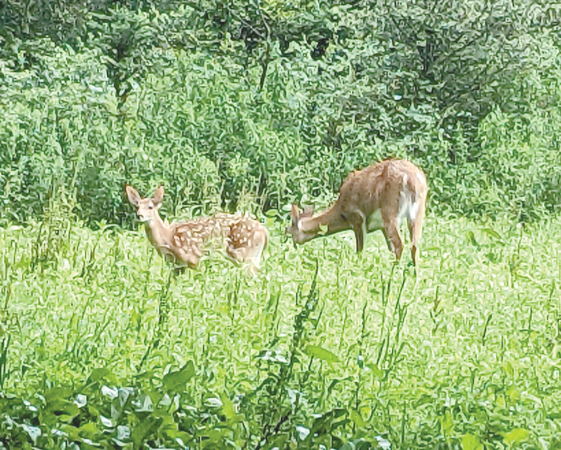One of the things I’m sure we all enjoy is going down the road and spotting young wild critters, and high on that list, I’m sure, are fawn deer. I and several others I’ve talked to have had one or more occasions where we had to stop our vehicles to avoid hitting one or two fawns standing on the road or slowly making their way across it. It’s also a sad sight to be going down the highway and seeing a dead fawn laying along the side of the road — a sight I’ve seen several times already this year.
On the lighter side, my wife and I have been watching several fawns and their mothers roam around the backyard over the past couple of weeks, and that’s what led me to write this piece. This morning, we watched two spotted fawns feeding in the overgrown grassy area behind the house; we never saw Mama. After about fifteen minutes, however, the fawns both suddenly looked up into the densely wooded cover nearby and immediately headed into it; no doubt Mama was calling for them to get back with her.
Now, we all know that fawns are born in the spring and hang out with their mother for some time, but I decided to look into the fawn deer thing a bit closer to learn more about the whole process. Here are some interesting points I gleaned from my reading.
For starters, just before giving birth, they will attempt to drive off their buck fawn or fawns from the previous year; apparently, it’s nature’s way of ensuring that inbreeding does not take place.
After a 200-day gestation process is complete, the young are born weighing in at six to nine pounds. Now, here’s something I didn’t know — right at birth, is usually about the only time in a fawn’s life that it is allowed to nurse while its mother is bedded. It’s critical for fawns to nurse as soon as possible since the doe’s milk, called colostrum, is full of antibodies that boost the fawn’s immune system.
Researchers at Cornell University have revealed some other facts I wasn’t aware of.
The researchers have placed the suckling stage of whitetail fawns into three phases: seclusion, transition, and juvenile ruminant.
The seclusion stage runs from birth to about ten days. During that stage, the fawns will crouch or hide separately from each other and depend on their speckled coat and inactivity to keep them from harm.
In the transition stage that runs to about day 50, the fawns can increase their weight to about 35 pounds and will be able to outrun a human. When fawns are about 2-3 weeks old, they start eating natural vegetation, and they will often accompany Mama in feeding areas.
In the juvenile ruminant phase, days 50-100, biologists believe that fawns are capable of surviving on their own should their mother be killed. Even though grazing and foraging have become a more important part of their feeding process, fawns will continue to actively nurse during this phase. At this stage, the average weight of a fawn will range from 35 to 50 pounds. Of course, as we all know, by mid-September, most fawns have lost their spots, and their daily activity is similar to that of other adult deer.
Well, needless to say, my wife and I will be checking each morning and evening to see if Mama allows the youngsters out into our backyard to feed and play for a while.




